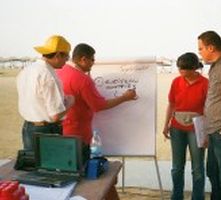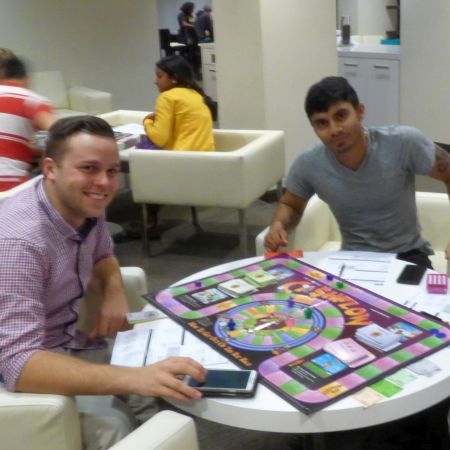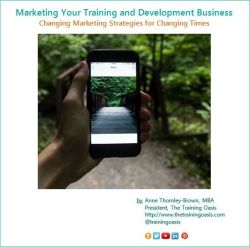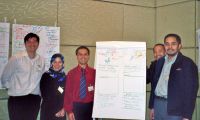
Spicing up Your Training
with Accelerated Learning

Conference and Training Design: How Accelerated Learning can Transform the Participant Experience
In 1996 I started The Training Oasis, Inc. In February, 1997, I launched our Spice of the Month Accelerated Learning Ezine to share tips for improving the effectiveness of training and development. In 6 years, the subscriber base grew to well over 4,000.
Corporate Training That Misses the Mark
Over 20 years ago, I heard Dave Meier from the Center for Accelerated Learning use the term "pour and bore" to describe seating participants in rows and boring them with presentations until they are in a comatose state.
It's 20 years later and there has been little change in the strategies that are used to offer training. There are new delivery channels and black and white overheads have been replaced by PowerPoint and Prezi, but the fundamental approach is the same.
Today, "pour and bore" is still the order of the day. I can't take credit for that term but it still applies.
The result of companies reducing the amount of time allocated for corporate training is that content is crammed into increasingly tight timeframes. This has created a challenging learning environment for introverts and analytical learners who need processing and "thinking time". It also shortchanges kinaesthetic learners who need to be actively engaged in the learning experience.
Conferences Crammed with Content

A little knowledge is a dangerous thing. Based on research about the average attention span of adult learners, presentations should be kept to no longer than 15 - 20 minutes.
Unfortunately, this research is often misinterpreted by conference and meeting planners. Adult learning theory has been so poorly applied that it is now common practice to change topics and speakers every 20 minutes. While Pecha Kucha, Ignite, TEDx Talk, and Campfire (at trade shows) formats make it possible to deliver content in short sound bites that are more compelling, they are abused. This parade of "talking heads" does not create more interactive or effective learning. It only prevents speakers from covering content in depth.
It would be far better to have fewer speakers and give them longer blocks of time. This would allow them use these formats to deliver compelling content and go deeper and deepr. These sound bite presentations could be immediately reinforced by meaningful participant exercises to provide an opportunity for reflection and application. A variety of approaches could be used individual exercises, exercises in pairs, trios, and small groups. The formats that could be used for these exercises include cases, write your own role-plays, forum role plays, brainstorming exercises, games, board games, card games, game shows, and more.
E-Learning: The Unfulfilled Promise
For well over a decade, to reduce the amount of time that employees are away from work, many companies have almost entirely scrapped face-to-face training and put most of their eggs in the e-learning basket.

This strategy is flawed for a number of reasons. While it has a chance of working for technical training, computers can't teach people management, interpersonal, and soft skills. Even technical training often requires hands-on practice to ensure skill mastery and proficiency.
As a rule, IT firms and professionals are "prime" in the e-learning development process. Instructional design and adult learning principles are not their areas of expertise.
"The Google trend graph for instructional design, the term and field of study, would seem to indicate that interest has declined steadily over the last 12 years. And while it looks to be flattening out, it is still trending downward."
- Brent Schlenker
This has resulted in tedious, text heavy page turners that miss the mark in terms of producing desired learning outcomes.
To save money, many organizations outsourced e-learning design to low cost foreign suppliers. The cost is low and so is the quality. Instructional design rates in North America have plummeted and instructional design is becoming a lost art.
In "Why Instructional Design is No Longer Trending" Learning and Development Specialist, Brent Schlenker, higlighte d the fact this downward trend in instructional design.
A Change in Focus
While I have still had the opportunity to design and facilitate interactive training and development programmes, primarily in Asia, the Caribbean, and the Middle East, there was definitely a shift in North America.
As a result, in 2003, I made the difficult decision to suspend publication of Spice of the Month Accelerated Learning Ezine. and retire the collection to a pay-to access archive.
For a while, the word "training" in my comany name became a liability. I re-branded and migrated my company's team building services to the Executive Oasis International brand.

I have applied my accelerated learning design skills to executive retreats, team building, and my own training and train the trainer programmes.
I have had the pleasure of working with companies from 18 countries in North America,the Caribbean (Jamaica, Barbados, Dominica), Asia (Singapore, Malaysia, Thailand, India), the Middle East (United Arab Emirates, Bharain, Saudi Arabia, and Africa (Egypt, South Africa, Sudan).
Future Forward
Today, many companies are realizing that e-learning will only get them so far. I have always believed that e-learning can be interactive and effective if it is designed based on solid adult learning principles. For example through the use of vivid images, colour, upbeat videos, and gamification, e-learning can be an excellent tool for covering information. This would reduce the need for boring presentations and carve out more time for practice and interaction when participants come together.

Companies are also re-thinking the importance of management development initiatives for emerging leaders as well as executives to address the challenges of improving employee morale and retention. Training to improve financial acumen is also becoming increasingly important.
The need to modify training to meet the needs of new generations with shorter attention spans and higher expectations with respect to production values is also being recognized.
Meeting and conference planners are recognizing the shortfalls of traditional instructional methods. In an effort to reverse the decline in conference attendance and association membership, many are eager to embrace gamification and other more interactive and effective approaches for delivering educational content.
Boosting Engagement with Accelerated Learning
Accelerated learning, which can transform the learning experience and conferences, is more relevant than ever. Facilitators, trainers, and conference organizers can:

- keep participants alert, active, and engaged throughout the learning experience
- reduce the amount of time that employees are away from their jobs for training
- streamline training and conference programmes and double their effectiveness
- help employees "hit the ground running" by focusing on results and relevant skills rather than theory
- make it easier for participants to grasp technical, theortical, and complex material
- increase retention by creating vivid and memorable learning experiences
What Does Accelerated Learning Look Like
Pre-Session
- participants are asked questions about their burning issues and concerns to shape content
- participants complete full inventory or mini-learning styles surveys to help facilitators uncover their preferences and tailor the instrurctional approach
- for conferences, breakout sessions are organized in tracks according to learning style preferences and this is highlighted in the marketing
During the Session
Set-up: Participants are seated at round or rectangular tables instead of in rows. Fishbowl arrangements also work well (circle with chairs or table in the middle for forum role-plays). Colourful posters and peripherals are on the walls. Music is playing. There is background video or a slide show of stunning images related to the topic on the screen.
- in trios or pairs, participants are engaged in a short session starter that is directly relevant to the topic
- presentation segments are sound bites of 15 - 20 minutes
- after each segment, participants will engage or collaborate through a meaningful exercise, brainstorming, discussion, game, or activity
- a cookie cutter approach will be avoided and, at times, in pairs, trios, or small groups, participants will have an opportunity to choose the exercise that is most relevant to them
- each exercise will be debriefed to uncover key learnings
- a variety of instructional methods from board games and game shows to cases and forum role-plays will be used
- a variety of approaches to brainstorming will be used
- once an hour, there is an energizer or mini-break
- for creative groups it could be a mini-vacation break, massage chain, dance break, or the introduction of tactile energizers
- for conservative audiences it could be 5 minutes to stretch, re-fill coffee, or take care of personal comfort
- review sessions are active, engaging, and participant centred - you'll never see the facilitator simply regurgitating content while participants doze off
- participants will formulate a plan to apply what they have learned when they return to work
Post-Session
- there will be specific tasks and assignments to ensure transfer of learning
- in a corporate setting, the immediate supervisor will provide coaching and support
- for conferences, a follow-up virtual or hybrid learning session would reinforce the experience and provide additional support
In short, participants would be active, alert, energized, and engaged before, during and after the session.
Want to learn more about how to leave boring training and educational sessions behind with accelerated learning?
Hot off the Press!
Our new e-book is now ready for purchase.
Spicing up Your Training with Accelerated Learning (PDF)
This 132 page e-book is jampacked with session starters, group exercises, games, brainstorming exercises, energizers, and more!
Download a Preview (PDF)
Browse the titles in the "pay per view" archives for our Spice of the Month Accelerated Ezine, They're filled with hundreds of tips, tools, and strategies that you can use immediately to improve the effectiveness of training, workshops, and conferences.














 Marketing the Training Function
Marketing the Training Function Launching a Training Business
Launching a Training Business Breaking Into Training & Development
Breaking Into Training & Development

